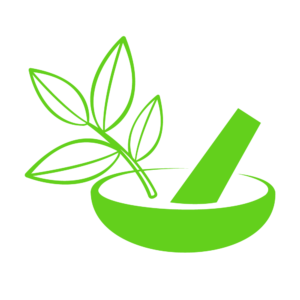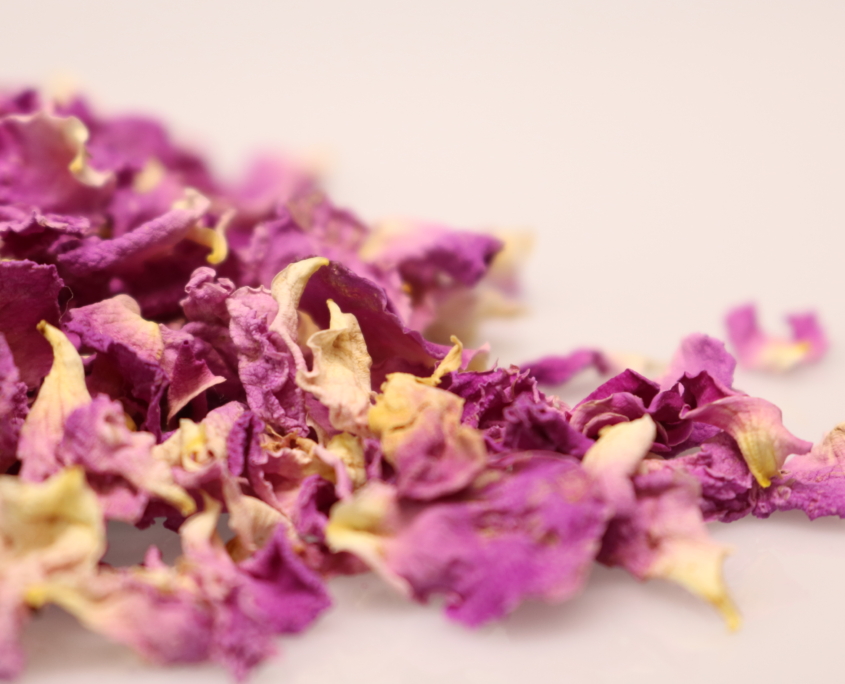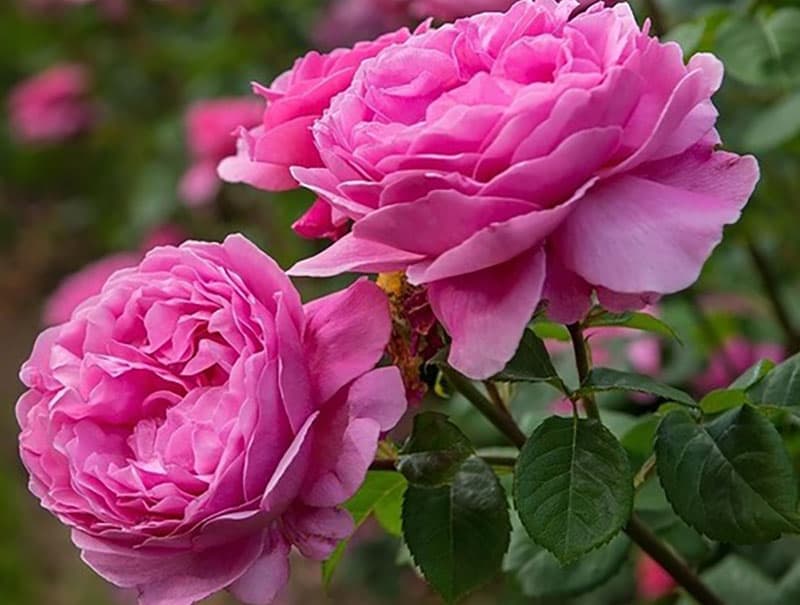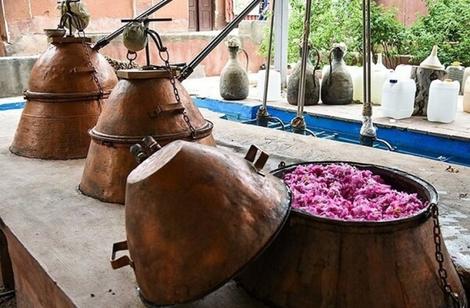Damask Rose
Common name: Rose
Persian name: گل سرخ، گل محمدی، گل گلاب
Scientific name: Rosa damascena
The Arabic name: ورد
French name: Rosier de damas
German name: Damaszener rose
Family Name: Rosaceae
Description
Rose is a perennial plant up to 1.5 meters high and sometimes higher, which has thorny stems. The leaves are composed of seven and sometimes nine oval leaflets with a sharp point and teeth. These teeth are regular and small. Leaflets are mutually placed on their axis. The flowers of the plant are relatively large and pink in color and have a pleasant and aromatic smell. Sometimes the petals may be white.
It seems that this species was created from a hybrid between Gallica and Kanina species. In the same source, he adds: Some botanists believe that this plant is a hybrid of Galica and Moshata species. This plant is grown in different parts of the world, including Iran, as an ornament or to use its essential oil.
Historical history of Rose consumption:
According to past experiences, roses are beneficial for the health of the skin and soul and have been used in medicine since ancient times. Romans recommended wild rose (Rose canina) to treat rabid dog bites. Rose was still used as an official medicine in the thirties. At that time, Rose Attar tincture (Rosa Gallica) was prescribed to treat sore throat. Rose is still very valuable. Its essential oil is very expensive and one of the most important essential oils in essential oil therapy. In Ayurvedic medicine, rose is considered one of the cold herbs that strengthen the mind. In new sources, the preparation of rose water from roses is attributed to Iranians for the first time. The same sources consider the great Iranian scientist Abu Ali Sina to be the first producer of aromatic distilled waters (medicinal aromatics) and their use in the treatment of diseases. Other nations were unaware of the preparation of essential oils and aromatic distilled water, and it seems that this experience came from Iran. transferred to other parts of the world. Since ancient times, the rose was known as the queen of flowers and its essence as the queen of flower essence or the queen of perfumes. Nicolas Call, an old botanist and someone who had enough knowledge about medicinal plants, considers the rose to be dominated by Nous. Although the preparation of rose water (GOLAAB) is attributed to ancient times, the preparation of rose essence is related to recent centuries.
- Principle
- Energy
- Carbohydrates
- Protein
- Fat
- Value/100g
- 49
- 11.31
- 0.96
- 0.64
- Unit
- Cal
- g
- g
- g
The method of making Rose water in the traditional way
Important ingredients:
Rose essential oil has two main parts, about 20% of which are saturated linear hydrocarbons that have 14 to 23 carbons. These compounds are ordinary paraffins, odorless and solid at normal temperature. The second part of the essential oil, which makes up nearly seventy percent of it, is made up of various alcohols, the most important of which are geraniol, which sometimes makes up to 70 percent of the essential oil), citronellol, nerol, and phenylethyl alcohol and a small amount of ester compounds. The sum of these two categories form an essential substance, which is solid at low temperature, semi-solid at normal temperature, and pale yellow liquid with the smell of geraniol at higher temperature. Considering that the amount of essential oil of petals is very low, only one kilogram of essential oil is prepared from every three thousand kilograms of petals, and the method of extracting essential oil is also very expensive. Rose essential oil is one of the most expensive perfumes. This essential oil is prepared in large copper cauldrons under special scientific conditions. It is prepared from four types of damasena, traditional foliah, galica and alba. The most important production centers of this essential oil are Bulgaria and Turkey, and a small amount is produced in the south of France and Germany. Iran is also one of the producers of rose water and rose essence.
Description of the benefits
Problems of women:
Rose essential oil is useful for many female problems. This essential oil strengthens the muscles of the uterus, especially in those whose uteruses are prolapsed, especially if it is combined with some yoga exercises, this problem can be solved better. It also has valuable effects on women who are ready to have an abortion due to the weakness of the uterus, as well as on the relief of menstrual problems, depression and nervous tension. Rose essential oil can reduce menstrual bleeding, regulate irregular periods, and eliminate ovulation disorders caused by irregular periods. It can also be placed in the body as a precursor of hormones like B vitamins and seems to increase sperm production.
Anti-depressant:
One of the reasons for the effect of rose essential oil as an antidepressant and an increase in sexual activity is the increase in brain activity. The same reason is also expressed regarding the increase of sexual desire in women by rose essence. Basically, rose essence was always used to increase sexual desire, and the Romans put rose petals in the new quilt of the bride and groom. Blood digests and stimulates the nervous system. But it is less used for this purpose.
Cosmetic:
Another important use of rose essential oil in cosmetic products is related to skin health. Rose essential oil is very suitable for all skin types, especially sensitive and dry skin and the skin of the elderly. Rose essence can increase the resistance of the capillary wall under the skin, which can be seen as red lines, and cure this problem to a great extent. Of course, in these cases, it is necessary to use essential oil for months.
Rose water:
Rose water is one of the best substitutes for rose essence, which is obtained by distilling rose petals with water. This material is very beneficial for skin health and eye disinfection. Of course, there is a type of rose water that is distilled three times and is known as “Triple Rosewater” which is a very good antiseptic and tonic for the skin. It is also a strong disinfectant suitable for the eyes.
Rose water is anti-inflammatory, cooling and softens the skin. It also has antimicrobial and astringent properties; For this reason, rose water has been used in skin products since ancient times. Rose essential oil is also used as skin products with natural oils or mixed with alcohols or essential oils of other plants. Although there is always a warning about the contact of essential oils with the eyes, rose water can be used as an eye wash to relieve tiredness and freshness. For this purpose, a sterile cotton cloth can be dipped in rose water and placed on the eyes. Also, in eye infections, sterile rose water can be used to wash and reduce infection and treatment.
Important things:
1- The best rose essential oil is obtained by the enflorage method and for this reason it has the highest price in the world, because in this method the essential oil does not change and has the best quality; While the essential oils that are obtained by the distillation method undergo changes due to the intervention of heat, which reduces their quality.
2- The method of extracting inflorescence is that fresh rose petals are placed on glass or porcelain plates covered with solid fat, after some time the essential oil of the petals is absorbed by the fat and then the petals are removed. They do this until the fat is saturated with essential oil, and then they extract the essential oil in the fat with an organic solvent and use the fat again. The organic solvent is separated from the essential oil under vacuum conditions and used again. High heat is not used and essential oil distillation is done under vacuum and low heat conditions. The essential oil is obtained unchanged. This method is more expensive than other methods of extracting essential oil, and as a result, the resulting essential oil is the best and most expensive.
3- Due to the fact that rose essential oil is very expensive, unfortunately many factories in the world use synthetic essential oils in their products. This type of essential oil is made from cheap materials and does not have the properties of natural rose essential oil. Therefore, many products in the world, despite having the smell of roses, do not have its valuable properties.
4- Rose water is one of the best cleansers and skin refreshing masks. To remove dirt and oil from the skin, especially in big and industrial cities like Tehran, where the air is polluted, you can clean your face with clean cotton dipped in rose water. This can be done several times a day. With this process, the pollution is removed and the skin exchanges with the air better through its pores. Also, with the absorption of rose water by the skin, blood circulation in the capillaries of the skin is accelerated and more food and oxygen reach the skin. You can also use rose water as a face mask after taking a bath, when the pores of the skin are more open and the skin is clean. The method of using it is the same as above, and after about 20 minutes, you can wash the rose water on your face. This process refreshes the skin and prevents It becomes wrinkled prematurely.
5- Although rose essential oil products can be used for all types of skin, it is better to use orange spring essential oil products for oily skin.
6- Good rose water should be completely clear and free of any sediment or external pollution and also have a pleasant smell of rose.
7- In order for rose water to last, it should be kept in completely closed glass or metal containers and in a cool place away from light. Plastic containers are not suitable for keeping rose water.
8- Rose water is actually a type of plant sweat in which rose essence is mixed with water vapor and becomes liquid after cooling in refrigerators and molecules of essential oil are placed next to water molecules. This aromatic solution is called the aromatic distilled water of rose or rose.
9- Most of the sources of effective ingredients and effects of rose petals and essence of the mentioned four types of rose are close and similar. Of course, the most commonly used rose in Iran is Damasna.
10- In Ibn Sina’s Book of Laws, it is written about the rose flower that it strengthens all parts of the inner organs. Dried flower is denser and colder. The best flower sap is the sap that is taken from the flower cut from the branch; on the condition that its appendages separate what is white from it. For flower jam, the flower should be dried in the shade and used. It prevents wounds, especially peeling wounds between the thighs and groins. Freshness is good for headache, and rose water also relieves headache. The flower is beneficial for sore eyes, if it is from heat, the boiled dried flower is applied to the eyes. Swelling of the eyelids. If he faints, he will wake up.Flowers are good for stomach and liver. Flower jam with honey strengthens the stomach and helps digestion. The flower and flower juice remove the moisture from the stomach. Flower oil suppresses stomach inflammation, flower syrup is useful for those who feel weak in the stomach. Flower juice or decoction of dried flower heals intestinal pain and its syrup is used to treat intestinal ulcers. Sleep on a bed of flowers, stop lust. Dried flower is not a laxative, but fresh flower can be a laxative. Calendula oil is laxative. The effects that Ibn Sina explained about the rose and its products are mostly similar to the newly reported effects, and in some cases where there are differences, they are certainly related to the states of the fresh and dry flower or the plant in different water conditions.
And the weather and geography are different, because these factors have a significant effect on the type of effective substances and its pharmacological effects. Even some effects of fresh and dry rose flowers are opposite. In many sources, fresh flowers are mentioned as laxative and dry flowers as astringent.
11- In terms of medicinal effects, apparently there is no difference between traditional and industrial rose water in Iran, because both types are obtained by distillation with water and heat is involved in both methods. It is just possible that these two types of rose water differ in terms of the concentration of essential oils or possible contamination, which depends on the conditions of the place, the devices and containers for extracting and storing rose water.
12- Most of Iran’s produced rose water, which is one of the best rose water in the world, is exported to wash blessed places.




